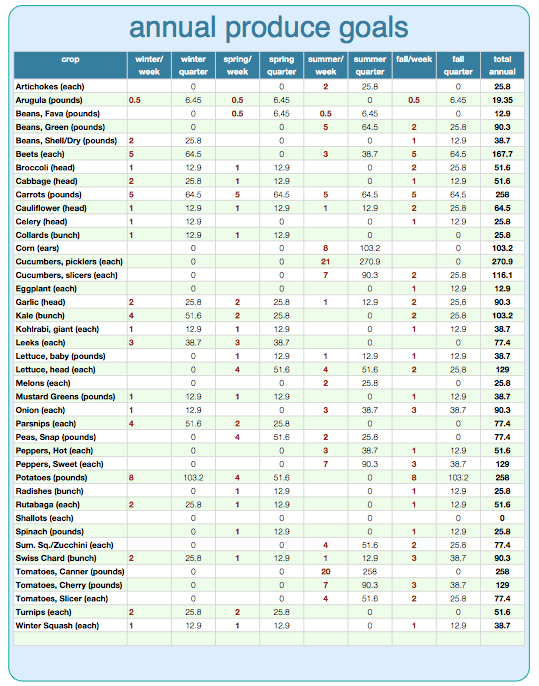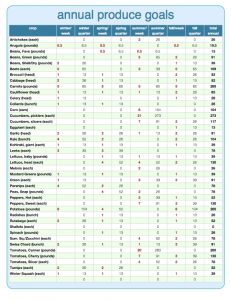One you you awesome readers has won The Urban Farm Handbook. But before you shoot right to the bottom of this post to find out if it’s you, read on to discover a great way to plan your harvest from the plate backwards. This is a technique straight out of The Urban Farm Handbook, so even if you didn’t win the book, you’re getting something really valuable for free.
So here we go. Let’s talk about how to plan your garden so that you have the best shot at growing enough of the right food, at the right time.
To do this you have to start by thinking about what you want to eat. This sounds simple, but anyone who’s ever made a weekly menu plan only to find out late in the afternoon that they don’t have a key ingredient for tonight’s dinner knows that there is some finesse involved with planning ahead. And any gardener who’s ever flipped through a seed catalog knows how essential eggplant seed looks, even though no one in the family will eat eggplant and you never, ever buy it. Throw in the variance of weather, soil, pests and your own personal learning curve over an entire year of gardening and things can get downright murky.
That’s where this produce planning chart comes in.
Download in: Excel 97-04 | Excel 07-10 | Numbers
This chart is so heavily inspired by one in The Urban Farm Handbook that I asked Annette Cottrell, co-author of that book, if she minded if I shared my planning tool. She not only graciously agreed, she pointed me to a slew of her own garden planning tools and spreadsheets, which she has made available to anyone. So if you like this kind of thing, check out Annette’s blog for more, and check back here because I’ll be taking about planning and organizing for the gardener a lot the next few weeks.
Here’s how this Produce Planning Chart works. You think about how much of XYZ Vegetable you want to eat per week, per season. Example: you figure out how much lettuce you want to eat per week in spring. You enter that value into the chart where “Lettuce” and “Spring/Week” intersect. The chart calculates how much you should aim to grow per season, and annually, based on your answers. Just fill in the values in the “Per Week” columns (the columns with the red example numbers) and everything else will be calculated for you.
The “Per Week” aspect of this chart makes planning for your harvest about as simple as thinking about what you’d order from a CSA box. As you are filling the chart out, think about what people in your family really eat, and in what quantity. Think about how much you’d like to have for preserving, if you want to do that at all. Think about allowing yourself “half-portions” of things if there are items you’d prefer to eat only every other week. Think about what extra you might grow to share with friends, family, and food banks.
There are a few drawbacks to keep in mind with this chart, but that should not stop you from using it.
First, if you are a true Urban Homesteader, you will probably not have the space to grow everything you set down on this chart. Who ever does? That’s ok! The version you can download has some rough numbers I put in for my family (we eat a lot) and you can see I booked myself for 20 pounds of canning tomatoes per week over the course of summer, or 258 pounds of ‘maters total. I will never grow that many tomatoes. However, I can buy that many tomatoes from an Eastern Washington farmer and preserve them as canned tomatoes and salsa for the rest of the year. So this is a great tool for source-it-local-Householder types too.
Second drawback: I don’t think our seasons divide cleanly into 3-month intervals. Winter is about right at three months, summer is usually about 5 or 6 weeks, and spring and fall make up the rest. But that’s ok, the planner still works. Just keep in the back of your head as you plan that if you are preserving, you need to plan for growing enough in summer to really pump it out, because you likely won’t be harvesting at those summer levels for a 3 full months.
Okay, let’s answer the question two-hundred-and-one of you are asking: “Who won the damned book, already!?”
Congratulations to comment 94, from Sarah who blogs at The Improbable Farmer, and who said, “My goal is to finally grow a balanced garden in my shady yard. I’ve had varied amounts of success in the past two years since moving into my house and this year I really want to have a plan, follow through, and eat from my garden all year. Your blog helps so much with this!”
Sarah, email me your address {nwedible (at) gmail (dot) com} and let’s get this book out to you.
Everyone else, thanks for entering. It’s really worth picking up a copy of this book, but if you want to test drive before you buy or reserve a copy at your library, check out Annette’s blog, Sustainable Eats, and the book’s blog, The Urban Farn Handbook for more.
Ok, who’s feeling inspired to go plan their garden now? I know I am!
6

I am not this organized yet. As I put together my seed order, I thought a lot about ‘specializing’ my garden though. Again because I have limited space, and because I want to buy as little as possible, I thought about what we really eat. Alot of it ended up revolving around my preservation goals. Next years Christmas presents: Pickles. We are going to need lots of cucumbers. Lots.
So we are focused on cucumbers, tomatoes, basil (for pesto), plus beans, spinach and potatoes, and few other things to fill in the edges. I know I will still have to buy some, and I know we will still be able to eat some (plenty). The fall garden is actually going to be more important for me in day to day production, if that makes sense.
So I’m thinking ahead, I’m just not diversifying much.
D or D – you might check out Harriet Fasenfest’s book, The Householders Guide To The Universe. Check your library. She practices what she calls “side dish gardening” which is growing with an eye to easy side dishes from the freezer or cupboard in the off season. I’m more of a crazy-cloching, kale-eating season extension year rounder, but either method is good based on what works for you and yours.
Thanks for the book recommendation Erica! I’ll check it out.
Got my grow op almost up and functional. I’m thinking of starting tomatoes this week or next. This seems totally ridiculous with snow reigning from the heavens outside.
Perfect! I’m linking up to this one. 😉 Thanks!
Thanks Anisa!
Ah, it doesn’t work for Mac, but that’s ok, because I already plan out what I need & use given what little space I have. I am planning getting the book soon anyway!
What problems are you finding for a Mac, Jen? It was designed on Numbers for Mac, so let me know what you’re seeing…Thanks!
Thanks for sharing this! It is a dizzying array of vegetables. I’m a little overwhelmed trying to plan our garden this year! Hopefully this will help me focus our needs/wants. If it helps, the sheet looks fine on my 8yo iMac.
Great article. Even though I didn’t win a book! Darn it. Maybe next time. Seriously though this is very important. Don’t waste time and energy growing food you won’t or don’t eat. It’s more common than you’d think. Thanks.
-Nathan
Erica – For your readers who don’t want to be bothered with computers or spreadsheets, John Jeavons (the guru of “biointensive” gardening) has a couple of very detailed “how much to plant?” charts in his book, “How to Grow More Vegetables”. His tables are designed for a one person “mini” garden as well as for a family of four.
Good luck with your garden. I read tonight that a blizzard of biblical proportions is heading your way.
Max in suinny So Cal
Yay! I went ahead and ordered the book based on the contest recommendation, and got it Friday.
Today was the first chance I had to start in on it (Thanks to our fickle Seattle Public schools dashing my routine, cough, snow scare, cough).
So this post with spreadsheets is perfect timing. I just got into my local PPatch, and hope to grow enough Kale, Broccoli, Peas, Cilantro, Blueberries and Basil to reduce our produce bill.
Thanks again:)
P.s. Even if you could have written a book like this, there is something like pixidust about the ability to read your posts, like a real time book that grows magically.
I agree, reading the posts one at a time in the appropriate season is perfect!
Hi there, I know this is an old post, but I was hoping to download this Excel spreadsheet. Unfortunately, it doesn’t seem to be available anymore (the Numbers one is but I do not have a Mac). Would you be willing to reupload it if you still have it somewhere? I would really appreciate it. Thanks so much, and either way, I really love your blog!
I can’t download the Excel files–I click the links and they don’t work. Could you please redirect me to where I can download them? Thanks.